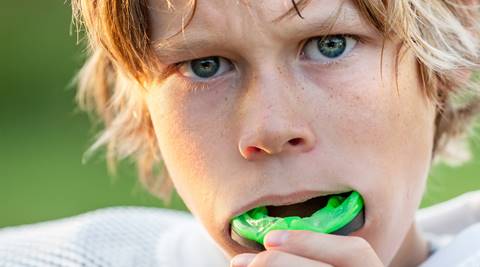
Young expatriates in Singapore are fortunate to be able to enjoy participation in sports like rugby, netball and soccer all year round. Indeed, many schools and organisations like ANZA provide ample opportunities to participate in competitive leagues while away from home. With thousands of young people playing contact sports in this country, it stands to reason that occasionally accidents will happen on the field. A number of orthodontic and dental bodies estimate that a third of all accidental injuries to youth happen while playing sports and that between 10 – 20{186f584e1648aa1811b9b9fa712dd7d2649c6ca5b99ce80aa7dea00e26f34f23} are maxillofacial injuries, many of which can be avoided and prevented.
One way to prevent orofacial injury is by wearing a properly fitted, protective mouthguard. If you thought that mouthguards were only necessary for football and hockey, you might be surprised to discover that because of the limited use of mouthguards, the majority of mouth injuries occur in such popular youth sports as baseball, basketball, soccer, softball and gymnastics. Another interesting fact is that young female athletes experience more oral and facial injuries than males.
The risk of sports related injury can be reduced via use of mouthguards. Injuries that can occur include broken, cracked and lost teeth as well as jaw and joint fractures. Mouthguards can also protect your gums and lips from lacerations during contact with equipment and other players. Players wearing braces may sustain serious mouth lacerations if the braces are hit with a ball or by another player. A guard can protect the metal brackets, teeth and soft tissues from damage.
There are a number of different mouthguards available. It is best to consult with your dentist or orthodontist about the best mouthguard for you. If you have a removable retainer or other removable appliance, consult your dentist before wearing it during contact sports.
Stock. The least expensive, stock type mouth guard cost only a few dollars and come in three sizes: small, medium and large. These are difficult to fit well to the dentition and some complain that they are too wide in the back, making on-field communication more difficult.
Boil and Bite.
Mouth-formed “boil and bite” mouthguards are fabricated by immersing the guard in hot water and softening the material so as to mold it to the players’ teeth. This type of appliance can be ill-fitting if not molded properly but offers good protection.
Custom-made mouthguards can be fabricated by a dentist for both adults and children, with or without braces. They are long lasting and very comfortable compared to the prefabricated models noted above. These guards should be replaced as children become teenagers due to the skeletal and dental changes occurring during growth. Custom made guards are the gold standard for protection of the teeth and jaw during sports due to their accurate fit. For heavier contact sports, guards with a microchip that measures the amount of impact to the structures of the face can also be made. This type of appliance can be a valuable tool in assessing the severity of an injury incurred during physical activity.
While mouthguards vary in price and comfort, they can all provide protection. According to the American Dental Association, the most effective mouthguard should be comfortable, tear resistant, cleansable and resilient. Always check your mouthguard for wear and tear or sharp edges. Remember that prevention is the key to avoiding dental trauma. Wear a guard so your teeth and surrounding tissues remain healthy and sound.
Expat Dental at Novena Medical Centre will supply and fit mouthguards for dental patients and those participating in any contact sports in Singapore. Contact us at info@expatdental.com for more information about the best mouthguard for you or your child.








